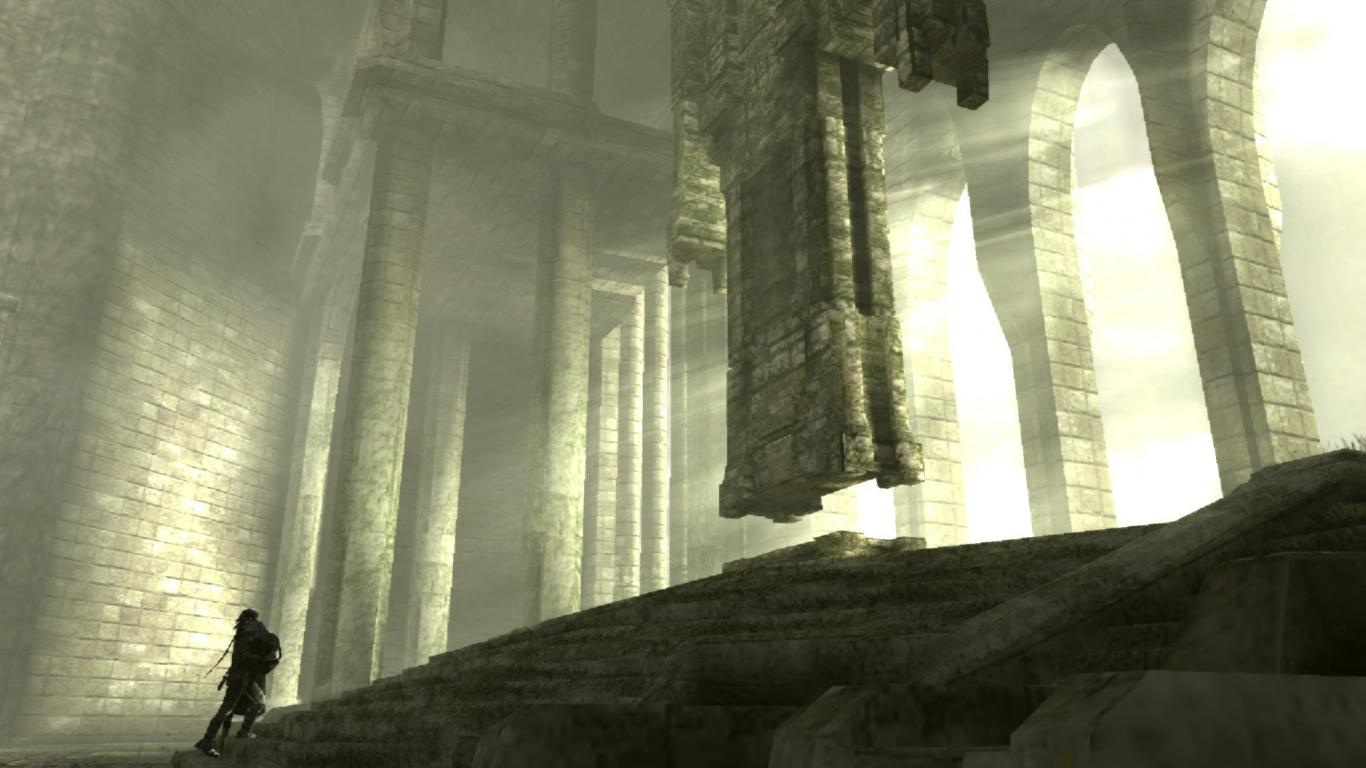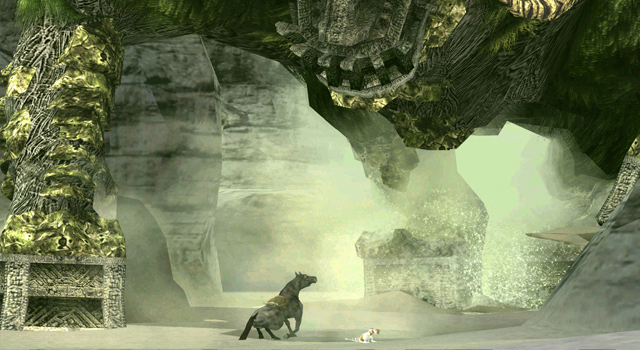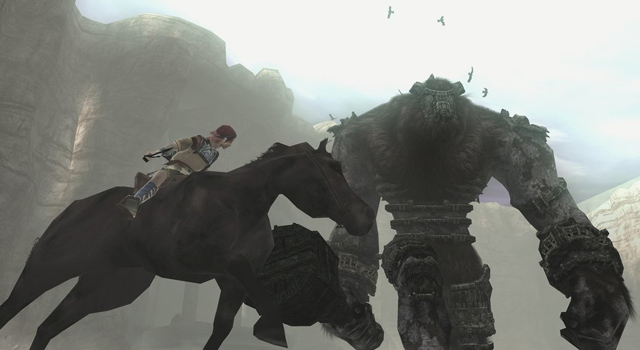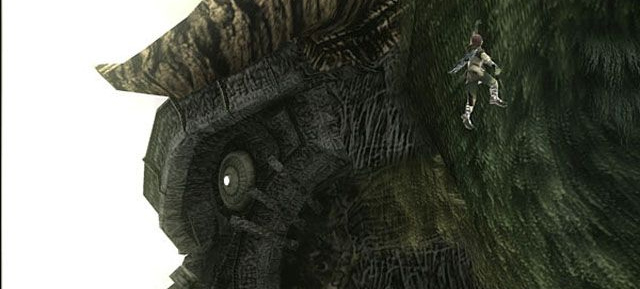Shadow of the Colossus
Just like any other visual medium, video games have conventions. Video games can play on these or avoid them to stir particular responses in players, and in turn players have begun anticipating what have developed into cliches.
Like other mediums, these tropes can become tired and result in backlash, as seen frequently in the recycling market of video games. Sometimes it feels like the video game industry is a creative graveyard, where bright ideas are squashed or at least dumped to the sidelines through indie games, and even the brightest developers rehash their own innovations. Even with this brand of cynicism, it’s possible to discover something new and be reminded that bold game design still exists in the mainstream. Certain games combine traits we are familiar with but tweak them and subvert them to deceive players, and in the case of Shadow of the Colossus, provide an uncanny experience that feels almost nostalgic, yet new. One of the most cited examples in the eternal “are games art?” debate, Shadow of the Colossus certainly looks the part. It is simultaneously slow, cinematic, dreary, and emotional. How did Shadow of the Colossus manage to create an experience that is all of these things, yet avoid the trappings of typical genres and conventions? How was Team ICO able to craft something so deep out of an experience that looks so shallow?
[status_oops]This article, like most articles on this site, contain spoilers. This article in particular talks at length about this game’s ending. You have been warned.
Shadow of the Colossus was developed by Team Ico of SCE Japan Studio. It was released on Playstation 2 in 2005. Currently, you can purchase SOTC remastered in high-definition with ICO for Playstation 3 or alone on the Playstation Network.[/status_oops]
[insert]
[/insert]
Shadow of the Colossus was released in 2005 as a Playstation 2 exclusive, in an era where games were becoming increasingly multi-platform as console technologies were becoming increasingly similar. Some gamers were eagerly awaiting Colossus after playing 2001’s Ico, the single and only game released by a small section of Sony Computer Entertainment Japan Studio with no games under their belt. Ico developed a cult following over night, but it was extremely inclusive. The vast majority of gamers still saw Colossus as an unknown original title, one that may have looked intriguing and earned a degree of hype from small circles on the internet, but it was a wild-card by a pretty large margin. The concept was a tough sell; Shadow of the Colossus has nearly no exposition, relying entirely on simplistic motivating factors to invest the player in the epic quest at hand. The world is stripped bare, with no villages or dungeons to explore. No small threats roaming the lands between your objectives. It breaks the fundamental rule of fantasy, to create a world of wonder and danger by alleviating any sense of danger outside of the colossi battles which are stagey, or the most “classical” design of any part of the game. The player is never ambushed and is visually queued by wide-open area-like spaces and some sort of movement or visual trigger to start the battle. The player can never feel underprepared. You might get away with labeling Colossus as a minimalist action-adventure title, yet even that description fails to capture the essence of the game, as it is frequently one of the most cinematically epic games ever created. A tough sell indeed.
Like Ico before it, Colossus makes it’s world epic in scope, stunningly realized, and ambiguous. The world is vast but empty with only birds, small lizards, and few fish occupying it. Though devoid of danger, there is no limit to the wonder. Rendered in taxing detail on the Playstation 2 that frequently resulted in performance issues (all cleared up in the PS3 re-release), the world isn’t often diverse but is frequently beautiful with beams of light streaming through foliage and vast landscapes revealing themselves beyond every gentle cliffside. This is one of the few games where persistent performance issues were widely overlooked because the beauty offered a larger payoff. There may be no other game that makes desolate look so wonderful.
[insert]
[/insert]
Upon starting Shadow of the Colossus, players are immediately greeted with a tone that is far removed from other contemporary games. A slow orchestral anthem that accompanies a hawk as it swoops through large canyons in a desolate land with a single, aged castle in the center. The game begins with a young man riding a horse with a dead woman slung limply over the horse with him. He enters this great ruin, what seems to be a former cathedral, and immediately begins speaking (in an eerie fictional language) to an unseen deity named Dormin who promises to resurrect the woman if the man can complete sixteen tasks, that is, destroy the physical entities of gods that roam the land. And that is about it. After that, the game operates almost like a silent movie where actions have consequence, no words necessary. Your character, dubbed Wander only by the instruction booklet, becomes a silent protagonist for the majority of the game, seemingly focused on his great task ahead. Wander’s past and his relationship to the dead woman are completely unknown as is the nature of these gods that now walk the earth as giant colossi. The alienating distance that the game creates also invites players to find compassion in the character of Wander as his quest is one of basic human motivation: for love out of desperation. He must risk his own life, over and over, against insurmountable odds, in order to save the life of this woman we don’t even know all with a sense of urgency, as if there is some invisible time limit we are never keen to.
[insert]
[/insert]
This resonates thematically as the game draws to a close. Wander’s intense focus and determination to save this woman actually highlights the true heart of Shadow of the Colossus: helplessness. Wander seems to be trying to control his own fate and the fate of those around them, but his is in actuality, a pawn to a higher order. Upon encountering the first colossi, the introductory cutscene highlights the insane scale difference between you and the beast, the monster’s immense power is illustrated by a mere footstep causing a tremor on the ground that shakes the camera, kicks up a storm of debris, and lets out a clap of thunder. By design, the player will always be overwhelmed when the colossi are in frame. In fact, holding down a button will lock the camera onto the enemy, with Wander in the foreground. The ridiculous low-angle position of the camera to fit both figures in the frame exaggerates an already absurd difference in size and power. The lock-on mechanic is usually reserved to assist the player in following a threatening enemy and moving strategically against it. Scale is usually compensated by zooming out, but here the feature is exploited to punish you as much as assist you. “I’m supposed to be able to kill that?” is the standard, open-jawed reaction to each enemy introduction. Once the game mechanics become more clear the player gains confidence, more skill and ease develop as the colossi wear on and their weaknesses become predictable and exploitable. Your stamina and health steadily scale as you progress, but this is laughably irrelevant in comparison to the colossi as they frequently shake you off and crush you in a couple blows regardless of your progress. But this progress is still important in developing the sense of confidence in the player, real or imagined. When you see your extended health and large stamina meters, you feel a sense of accomplishment or re-assurance when you reflect on how little you begin with. It’s visible progress, but it won’t help you in the least. As the game goes on, the colossi remain a massive threat, seeing as they are the only threat in the game. Every strategy you learn does not translate from one colossi to the next and your approach needs to constantly be recalculated. It’s a relentless give-and-take with your own endurance, and by extension, the endurance of Wander to persevere against these seemingly invincible goliaths.
It isn’t until the final moments of the game that this perception is put into stunning perspective. I have argued that Shadow of the Colossus has one of the best, if not the best, endings of all time and here is why: once Wander defeats the final colossus, what seems like a living Tower of Babel, he realizes all this darkness he pulled from the living Earth needs to go somewhere: into him. Just as knights following Wander’s trail from his nearby homeland arrive and scorn him for his ignorant, foolish mistakes, Wander is consumed by darkness and death and becomes a colossi himself. Confused, the player must figure out how to play as this giant beast while they have become accustomed to, for the last eight or so hours, playing as a small agile human. Suddenly the awkwardness and slow lumbering movements of such a mammoth beast make it feel like you’re playing wrong. You can barely fit inside the walls you are between, it is difficult to turn and your attacks have such weight you can only lift your arms fast enough to stop every fifth arrow from going into your side. There is no tutorial, no preparation or explanation. Suddenly, the player realizes what it is to be on the other side of the fight. The game feels like a constant reminder of your own mortality as you hover like a house-fly on the backs of giants, so when you become the giant you realize the perstering persistence of ant-like humans. But most of all, you feel helpless. Your old perception of the colossi being giant, monstrous, and hostile is extinguished making room for sympathy. To make matters worse, you only gain this knowledge after being tricked by the evil Dormin to resurrect the deity in its full strength. What it didn’t tell you from the outset was that in order to save your love, not only must you trade your own life, but you must release evil incarnate onto the world. Your trustful steed nearly dies in service of your quest, sixteen colossi of the Earth are destroyed, and you end up sacrificing yourself for a noble, but foolishly naive deed; there is a sincere idea of sacrifice at the heart of this game.
[insert]
[/insert]
A monumental achievement on both artistic and technical grounds, Shadow of the Colossus is refreshingly stubborn towards its role in guiding the player. Instead, Team ICO gambled that players will follow the lead of gorgeous imagery, a redemption love story, and a stripped-down interface. They bet right. Ico was fairly simplistic, but beautifully executed. Shadow of the Colossus on the other hand was a game very late in the Playstation 2 life and was one of the few that was able to take full advantage of the technology. There is probably no other game (maybe God of War II) that looked this good on the PS2. It pushed the system to the brink, so much so that many of the huge colossi would cause some aforementioned performance issues with the frame rate. The opening title screen shows the huge draw distances and unique vistas that shaped the land. A heavy use of bloom lighting and motion blur sold the game’s aesthetic, but the true jaw-droppers were the colossi themselves. Living up to it’s title, the colossi were as massive as mountains, diverse and all products of creative ingenuity. God of War II‘s Colossus of Rhodes boss battle had similar scale, but lacked the freedom and threatening spontaneity of these colossi because it was heavily scripted. Colossi in this game have a set series of attacks, but move and search for you in constantly unique ways, making them feel even more dangerous and unpredictable. There are no “running the motions” in this game. When the colossi move, they sway their entire bodies, their massive legs tear up the hard, dry ground in large plates — just being in the vicinity of one of these feet as they hit the ground will cause Wander to lose his balance, and often take some damage from the shockwave. The graphical effects went along way to make climbing the massive beasts as epic as possible and as frighteningly stressful as well, it is a long way down after all.
Often compared to the Legend of Zelda series, Shadow of the Colossus does operate like those 3D adventures in many ways: a lone hero with a horse who uses his mythical sword to vanquish great beasts from different parts of a complex ancient world. The difference however, is that Zelda has you traverse complex dungeons with a huge array of tools and weapons before the final showdown. Shadow of the Colossus is stripped down, it looks like nothing but a boss battle, when in fact each colossi are a dungeon and boss packed into one. Each colossi is a well-designed puzzle, it is rarely apparent how to hurt them, and even less so to climb on them. You will spend lots of time running around the beasts looking for an entry point to which you can scale the rest of your way. It takes time, patience, reflex, and insight to properly scale and defeat a colossi. Finally defeating a colossus and watching it collapse under its own weight while your character clings to its massive body, visible only as a minuscule speck on the beast is among the most satisfying experiences you can have in a video game. Lucky games have one of these moments, Shadow of the Colossus has sixteen.
[insert]
[/insert]



